“True, knowledge is power. But we forget, knowledge is also beautiful in the abstract and in real.”
These libraries are testaments to the enduring and inspiring energy we draw from architecture, art, sciences, and the human spirit.
But one must wonder about this seemingly chicken-and-egg situation: is civilisation inspired by libraries or are libraries inspired by civilisation.
Just like any art-imitating-science and science-imitating-art discourse, the best way to an informed decision is to see for yourself, both digitally and in real.
As they say, carry on.

From our partners:
No. 1 | Trinity College Library
Dublin, Ireland
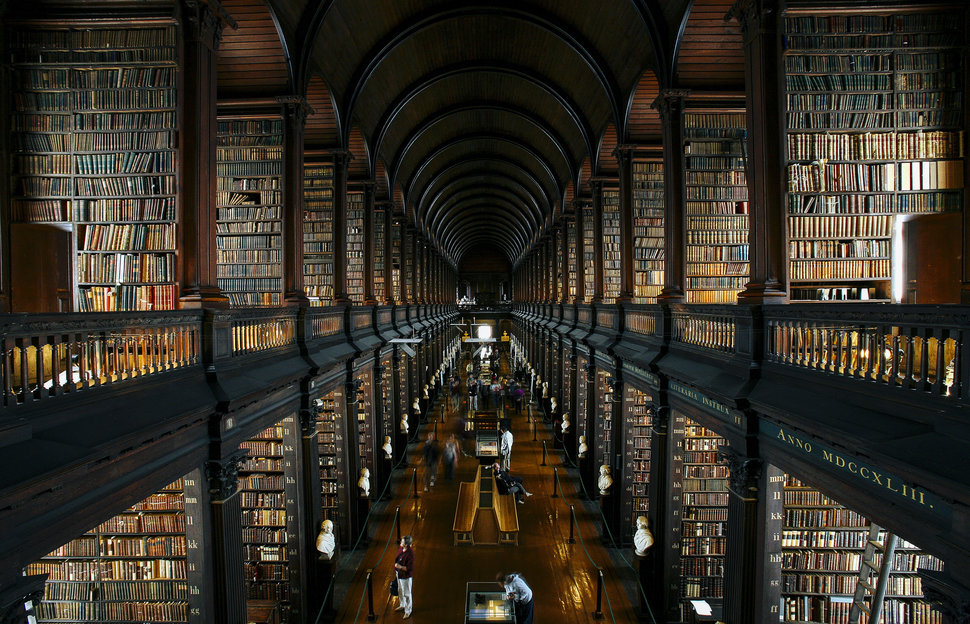
The Library is the permanent home to the famous Book of Kells. Two of the four volumes are on public display, one opened to a major decorated page and the other to a typical page of text.
The Library proper occupies several buildings, four of which are at the Trinity College campus itself, with another part of the Trinity Centre at St. James’s Hospital, Dublin.
The 65-metre-long (213 ft) main chamber of the Old Library, the Long Room, was built between 1712 and 1732 and houses 200,000 of the Library’s oldest books. The Long Room is measured at almost 65 metres long. After it was first built The Long Room had a flat ceiling, shelving for books only on the lower level, and an open gallery. By the 1850s the room needed to be expanded as the shelves were filled due to the fact that the Library had been given permission to obtain a free copy of every book that had been published in Ireland and Britain. In 1860, The Long Room’s roof was raised to accommodate an upper gallery.
No. 2 | Austrian National Library
Vienna, Austria
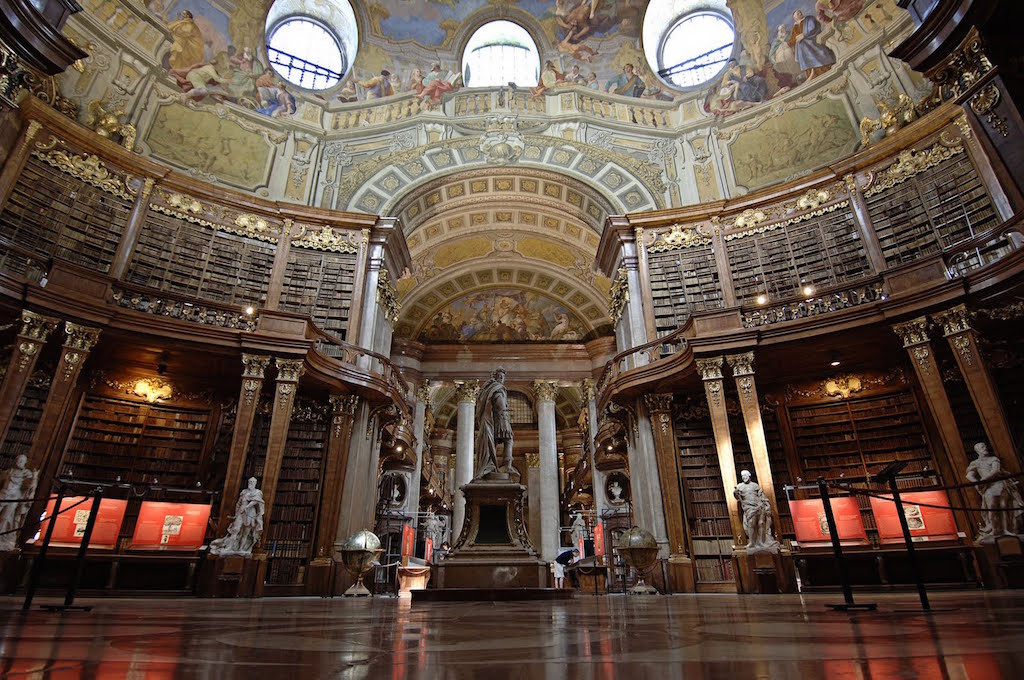
Austrian National Library is the largest library in Austria, with 7.4 million items in its various collections. Founded by the Habsburgs, the library was originally called the Hof-Bibliothek “Imperial Library”. The change to the current name occurred in 1920. The library is located in the Hofburg Palace in Vienna. The library complex includes four museums, as well as multiple special collections and archives.
One of the major tasks of the Austrian National Library is the collection and archiving of all publications appearing in Austria including electronic media. Depending on the law for the medium, four copies, and by other printing elements, two obligation copies each, must be delivered to the National Library by periodic printing elements appearing in Austria.
No. 3 | Library Of Congress
Washington D.C., USA
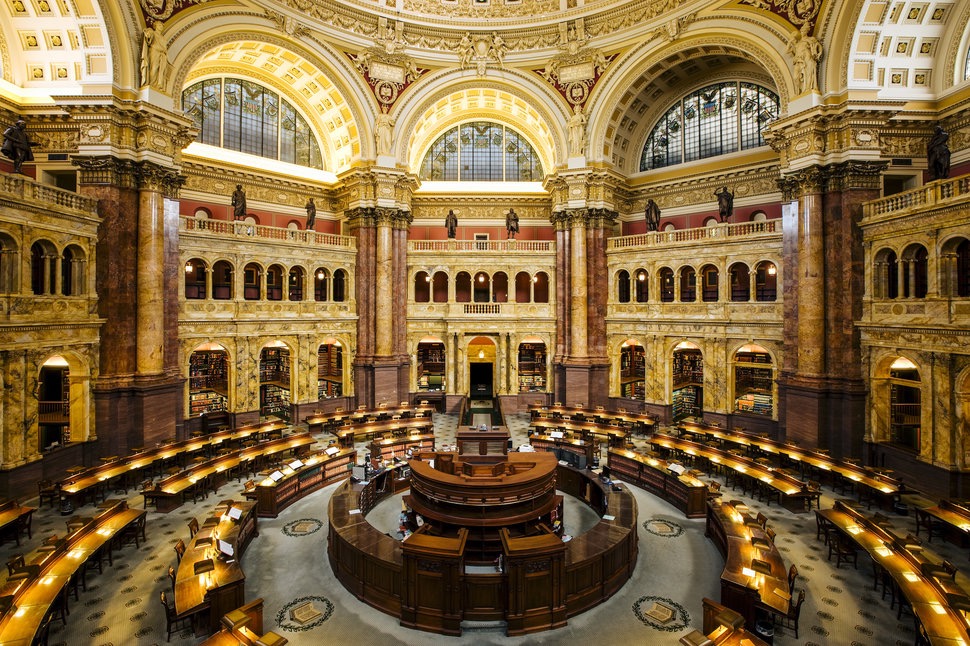
The Library of Congress is the nation’s oldest federal cultural institution and serves as the research arm of Congress. It is also the largest library in the world, with millions of books, recordings, photographs, maps and manuscripts in its collections.
The Library’s mission is to support the Congress in fulfilling its constitutional duties and to further the progress of knowledge and creativity for the benefit of the American people.
The Library of Congress was established April 24, 1800, when President John Adams signed an act of Congress providing for the transfer of the seat of government from Philadelphia to the new capital city of Washington.
No. 4 | Bibliothèque Nationale de France
Paris, France
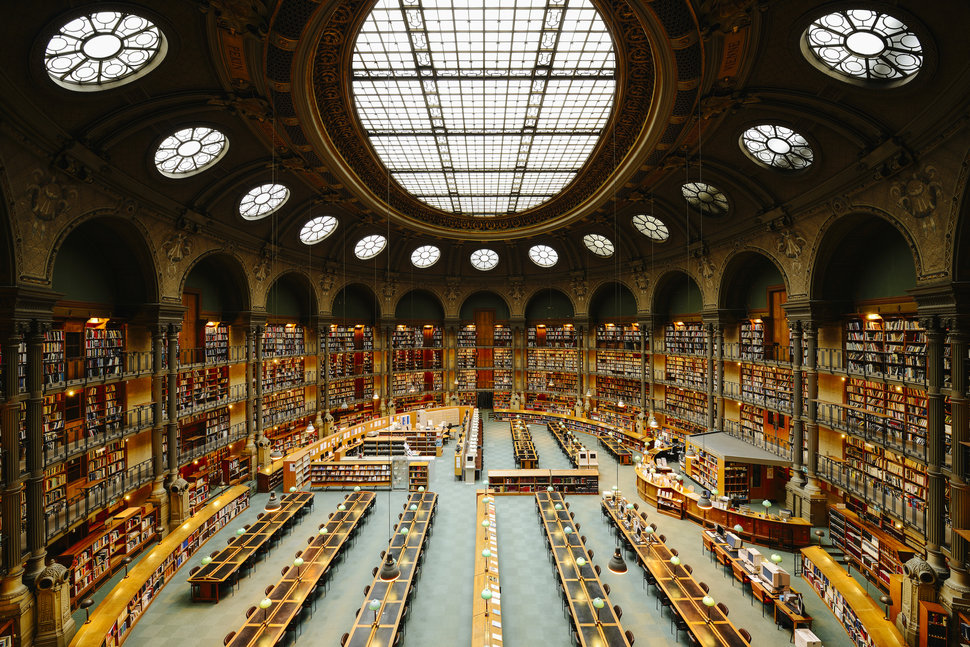
Bibliothèque Nationale de France is the National Library of France, located in Paris. It traces its origin to the royal library founded at the Louvre Palace by Charles V in 1368 and preserves and makes known the national documentary heritage.
The BnF’s collections are unique in the world: 14 million books and printed documents, manuscripts, prints, photographs, maps and plans, scores, coins, medals, sound documents, video and multimedia documents, scenery elements. All disciplines, whether intellectual, artistic or scientific, are represented in a comprehensive way. About 150 000 documents are added to the collections each year thanks to legal deposit, acquisitions and donations.

No. 5 | Stuttgart Municipal Library
Stuttgart, Germany
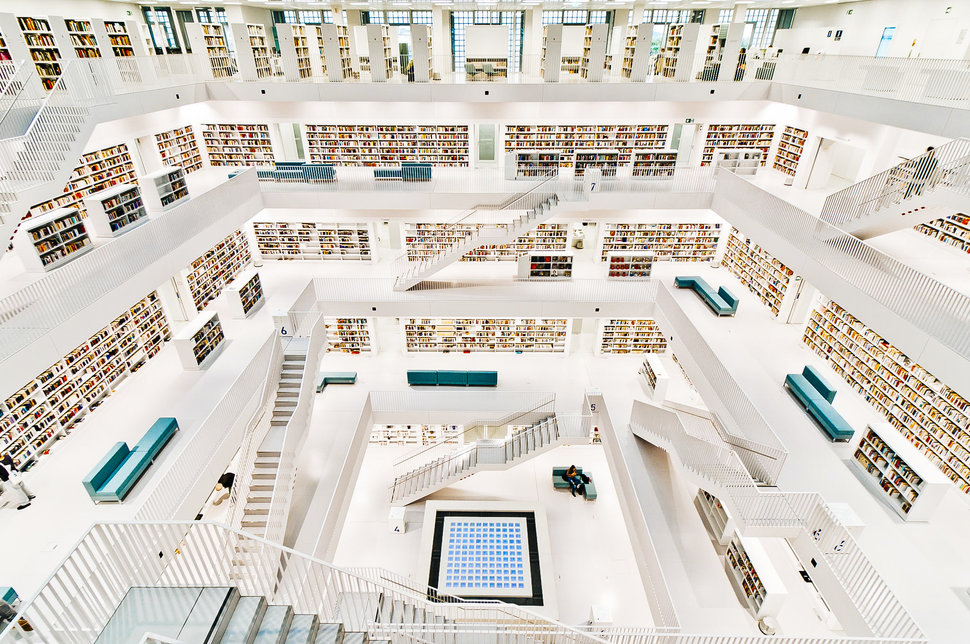
The new 9-storey library building deliberately takes its cue from the block structure of the projected 7-storey buildings in the area, and rises up like a great crystalline cube within the grassed area at Mailänder Platz.
The Municipal Library has become Stuttgart’s new intellectual and cultural centre that is open to people of every nation. This is also symbolised by the inscriptions on the outer walls: the word “Library” in silver letters is in English on the west wall, in German on the north, in Korean on the East and in Arabic on the south.
No. 6 | Royal Portuguese Reading Room
Rio de Janeiro, Brazil

The Real Gabinete Português de Leitura (English: Royal Portuguese Reading Room) has the largest and most valuable literary of Portuguese outside Portugal. Constructed between 1880 and 1887, it has more than 350,000 volumes in a library, fully computerized, which brings together rare books from the XVI, XVII and XVIII. The library receives a copy of Portugal for each of the works published in the country according to its status of “legal deposit”.
Its incredible architecture beauty and its rich collection transport you to the 19th century when you visit this library in Rio de Janeiro.
No. 7 | State Library of Victoria
Melbourne, Australia
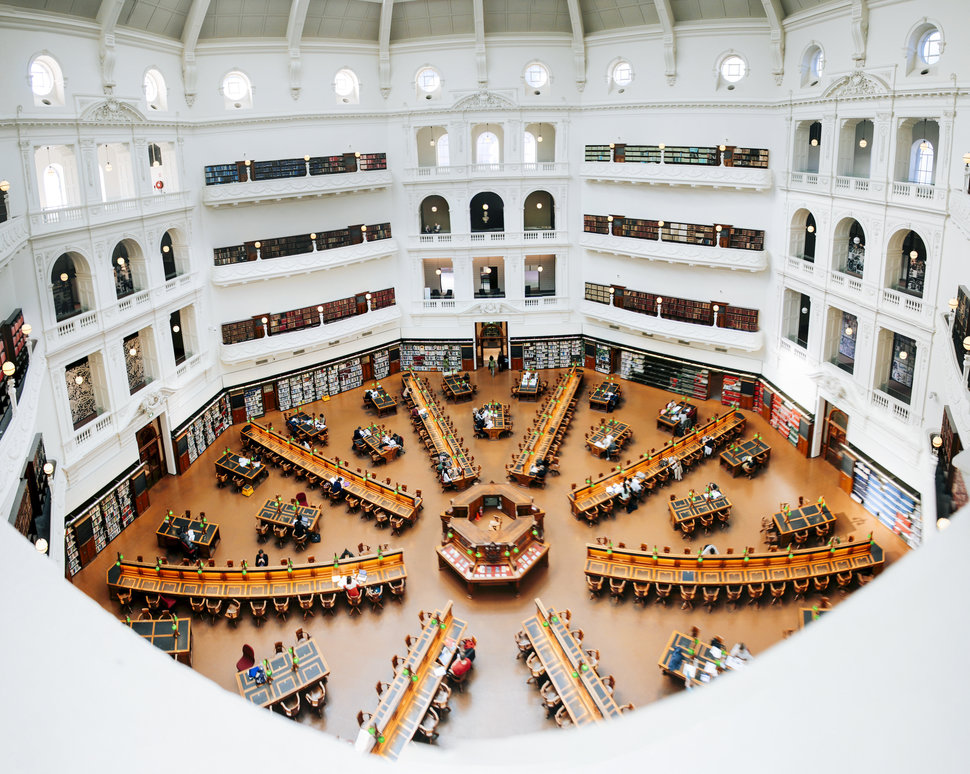
The State Library of Victoria is the central library of the state of Victoria, Australia, located in Melbourne. It is on the block bounded by Swanston, La Trobe, Russell, and Little Lonsdale streets, in the northern centre of the central business district. The library holds over 2 million books and 16,000 serials, including the diaries of the city’s founders, John Batman and John Pascoe Fawkner, and the folios of Captain James Cook, R.N.
The Dome Galleries at the Library include two permanent exhibitions – Mirror of the World: books and ideas which features the Library’s History of the Book collections (including a rare folio of Audubon’s Birds of America)and The Changing Face of Victoria which examines the social history of Victoria (which includes the armour of the notorious bushranger Ned Kelly).
Also that the Library is visited by over 1.7 million people every year and has digitised large amounts of its historical collections which can be accessed online.
No. 8 | University of Aberdeen Library
Aberdeen, Scotland
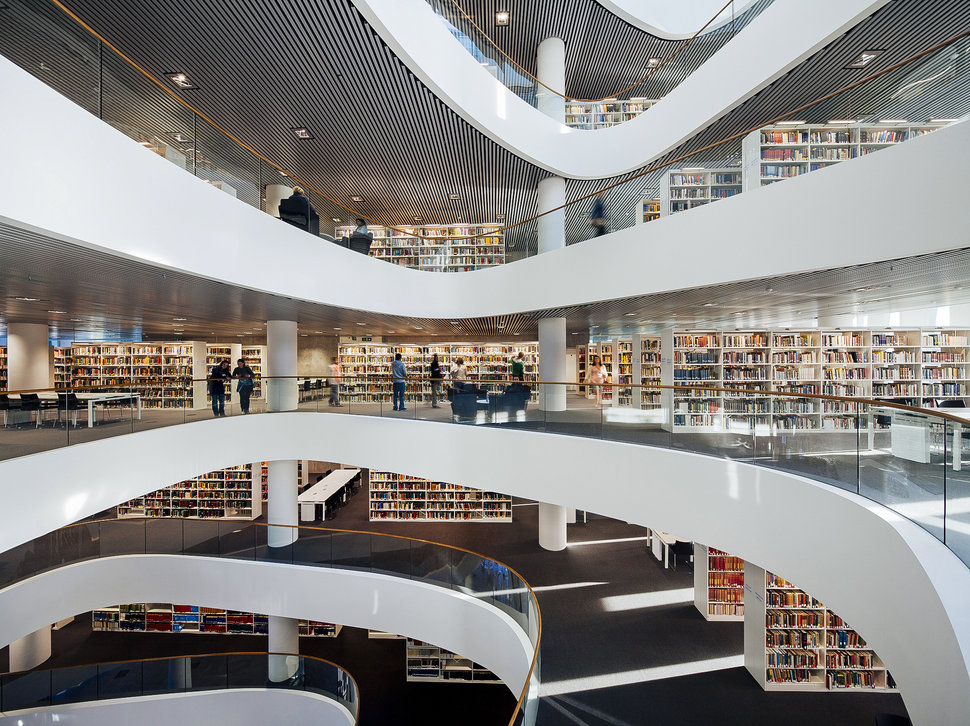
On September 24th 2012, Her Majesty Queen Elizabeth II of Great Britain marks the official opening of the University of Aberdeen New Library in Scotland. The building, won in an architectural competition in 2005 by schmidt hammer lassen architects, is replacing the University’s former library from 1965 – the Queen Mother Library.
The 15,500 m² new library, which provides a 21st century learning and research environment for students, university staff, visitors and the public, is a positive example of how architecture can make a difference. Since the building was put into service in September 2011, the statistics have shown a significant increase in the use of the library, and more than 700,000 visitors have entered the building this first year of operation.
“The University of Aberdeen New Library functions as a meeting place and a cultural centre for the students of the University as well as the Aberdeen community.”

No. 9 | Admont Abbey Library
Admont, Austria
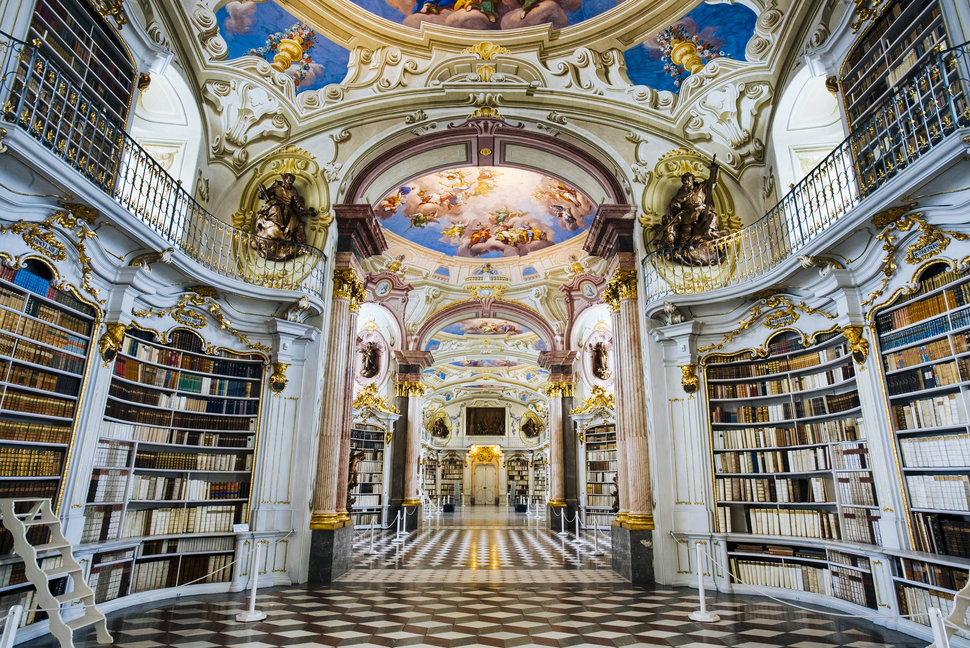
Admont Abbey (German: Stift Admont) is a Benedictine monastery located on the Enns River in the town of Admont, Austria. The oldest remaining monastery in Styria, Admont Abbey contains the largest monastic library in the world as well as a long-established scientific collection. It is known for its Baroque architecture, art, and manuscripts.
The library hall, built in 1776 to designs by the architect Joseph Hueber, is 70 metres long, 14 metres wide and 13 metres high, and is the largest monastery library in the world. It contains c. 70,000 volumes of the monastery’s entire holdings of c. 200,000 volumes. The ceiling consists of seven cupolas, decorated with frescoes by Bartolomeo Altomonte showing the stages of human knowledge up to the high point of Divine Revelation. Light is provided by 48 windows and is reflected by the original colour scheme of gold and white. The architecture and design express the ideals of the Enlightenment, against which the sculptures by Joseph Stammel of “The Four Last Things” make a striking contrast.
The abbey possesses over 1,400 manuscripts, the oldest of which, from St. Peter’s Abbey in Salzburg, were the gift of the founder, Archbishop Gebhard, and accompanied the first monks to settle here, as well as over 900 incunabulae.
No. 10 | Bibliotheca Alexandrina
Alexandria, Egypt
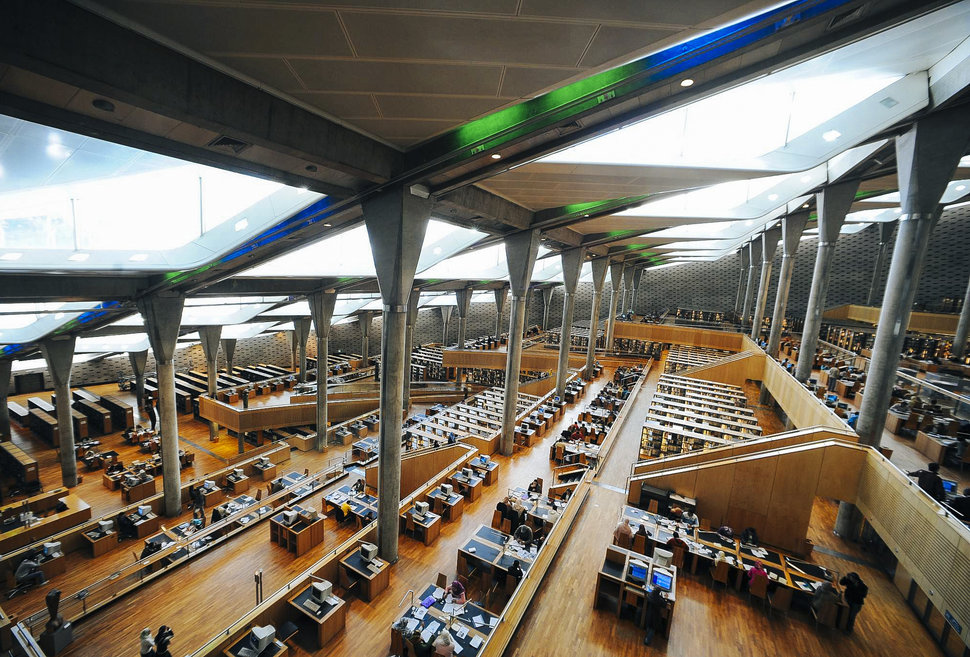
Bibliotheca Alexandrina is a major library and cultural center located on the shore of the Mediterranean Sea in the Egyptian city of Alexandria. It is both a commemoration of the Library of Alexandria that was lost in antiquity, and an attempt to rekindle something of the brilliance that this earlier center of study and erudition represented.
The Library of Alexandria was reborn in October 2002 to reclaim the mantle of its ancient namesake. It is not just an extraordinarily beautiful building; it is also a vast complex where the arts, history, philosophy, and science come together.
The dimensions of the project are vast. The library has shelf space for eight million books, with the main reading room covering 70,000 square metres (750,000 sq ft) on eleven cascading levels. The complex also houses a conference center, specialized libraries for maps, multimedia, the blind and visually impaired, young people, and for children, four museums, four art galleries for temporary exhibitions, 15 permanent exhibitions, a planetarium, and a manuscript restoration laboratory. The library’s architecture is equally striking. The main reading room stands beneath a 32-meter-high glass-panelled roof, tilted out toward the sea like a sundial, and measuring some 160 m in diameter. The walls are of gray Aswan granite, carved with characters from 120 different human scripts.
No. 11 | Bodleian Library
Oxford, United Kingdom

Bodleian Library is one of the oldest libraries in Europe, and in Britain is second in size only to the British Library with over 11 million items. Known to Oxford scholars as “Bodley” or simply “the Bod”, under the Legal Deposit Libraries Act 2003 it is one of six legal deposit libraries for works published in the United Kingdom.
The New Bodleian building was rebuilt behind its original façade to provide improved storage facilities for rare and fragile material, as well as better facilities for readers and visitors.
It reopened to readers as the Weston Library on 21 March 2015. In March 2010 the group of libraries known collectively as “Oxford University Library Services” was renamed “The Bodleian Libraries”, thus allowing those Oxford members outside the Bodleian to acquire the gloss of the Bodleian brand.
No. 12 | Biblioteca Joanina
Coimbra, Portugal

The Joanina Library (Biblioteca Joanina) is the Baroque library of the University of Coimbra, built in the 18th century during the reign of the Portuguese King João V and named after him. It is located in upper Coimbra, the university historic centre, near the university tower, and is part of University of Coimbra General Library.
Over the entrance door, the library exhibits the national coat of arms. Inside, there are three great rooms divided by decorated arches, bearing the same style as the portal and entirely executed by Portuguese artists. The walls are covered by two storied shelves, in gilded or painted exotic woods; the painted ceilings, by the Lisbon artists Simões Ribeiro and Vicente Nunes, blend harmoniously with the rest of the decoration. The library contains about 250 thousand volumes, namely works of medicine, geography, history, humanistic studies, science, civil and canon law, philosophy and theology. It is a National Monument and has a priceless historical value being one of the main tourist attractions among the older monuments belonging to the university.
No. 13 | The Royal Library
Copenhagen, Denmark
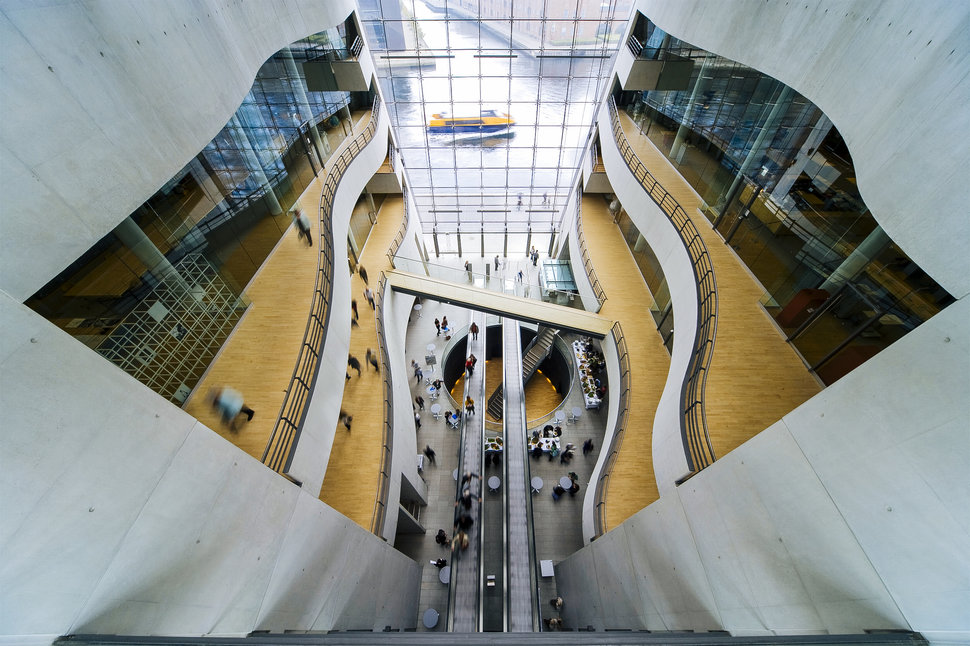
The Royal Library is the national library of Denmark and the university library of the University of Copenhagen. It is the largest library in the Nordic countries. It contains numerous historical treasures; all works that have been printed in Denmark since the 17th century are deposited there.
Today, The Royal Library has five sites: The main library at Slotsholmen, Copenhagen harbour (in the Black Diamond), covering all subjects and special collections; one at Nørre Alle, Faculty Library of Natural and Health Sciences; one at Gothersgade, central Copenhagen, Faculty Library of Social Sciences; one at Amager, Faculty Library of Humanities; and, one in Studiestræde, central Copenhagen, The Faculty of Law Library.
No. 14 | Delft University Of Technology Library
Delft, Netherlands
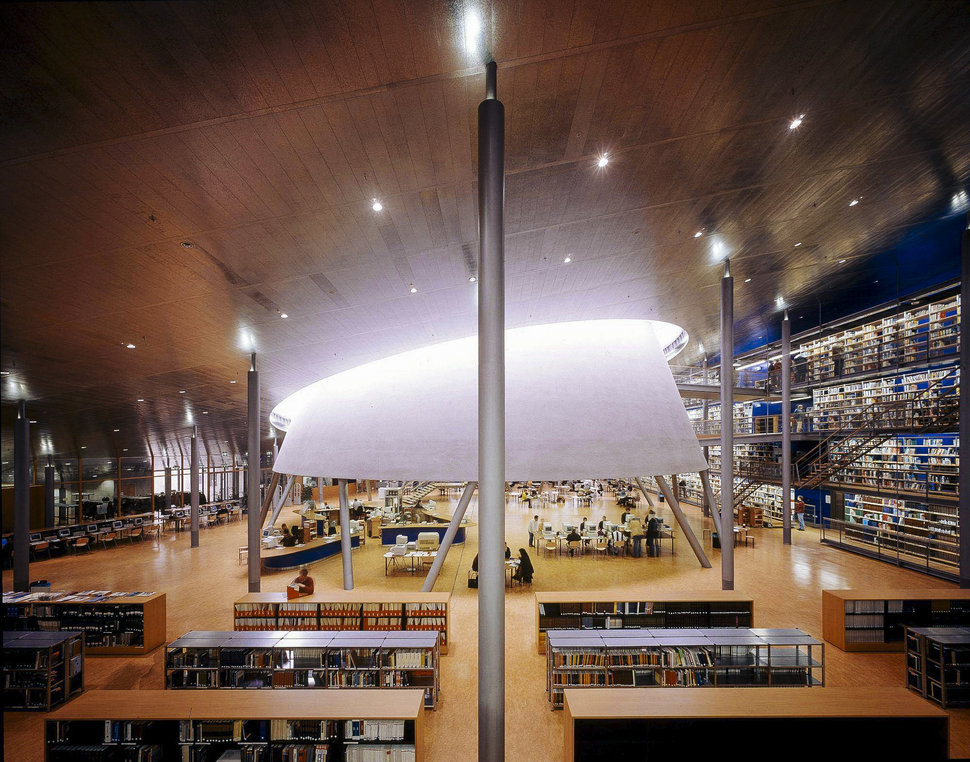
Delft University Of Technology Library also known as TU Delft, is the largest and oldest Dutch public technical university, located in Delft, Netherlands. With eight faculties and numerous research institutes it hosts over 19,000 students (undergraduate and postgraduate), more than 3,300 scientists and more than 2,200 people in the support and management staff.
The university was established on January 8, 1842 by King William II of the Netherlands as a Royal Academy, with the main purpose of training civil servants for the Dutch East Indies. The school rapidly expanded its research and education curriculum, becoming first a Polytechnic School in 1864, Institute of Technology in 1905, gaining full university rights, and finally changing its name to Delft University of Technology in 1986.
No. 15 | El Escorial Library
Escorial, Spain

The Royal Site of San Lorenzo de El Escorial commonly known as El Escorial, is a historical residence of the King of Spain, in the town of San Lorenzo de El Escorial, about 45 kilometres (28 miles) northwest of the capital, Madrid, in Spain. It is one of the Spanish royal sites and functions as a monastery, royal palace, museum, and school. It is situated 2.06 km (1.28 mi) up the valley (4.1 km [2.5 mi] road distance) from the town of El Escorial.
El Escorial is situated at the foot of Mt. Abantos in the Sierra de Guadarrama. This austere location, hardly an obvious choice for the site of a royal palace, was chosen by King Philip II of Spain, and it was he who ordained the building of a grand edifice here to commemorate the 1557 Spanish victory at the Battle of St. Quentin in Picardy against Henry II, king of France.
The library’s collection consists of more than 40,000 volumes, located in a great hall fifty-four meters in length, nine meters wide and ten meters tall with marble floors and beautifully carved wood shelves. The library includes many important illuminated manuscripts, such as the Ottonian Golden Gospels of Henry III.
The vault of the library’s ceiling is decorated with frescoes depicting the seven liberal arts: Rhetoric, Dialectic, Music, Grammar, Arithmetic, Geometry and Astronomy.
No. 16 | Biblioteca Marciana
Venice, Italy
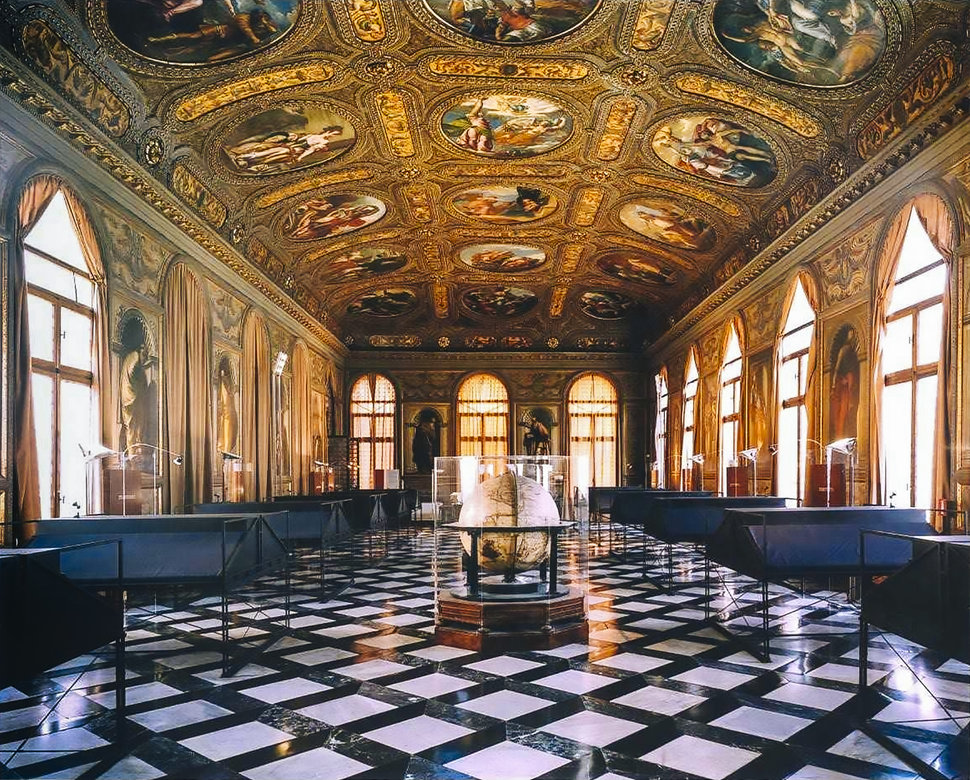
The Biblioteca Nazionale Marciana, the National Library of St Mark’s is a library and Renaissance building in Venice, northern Italy. It is one of the earliest surviving public manuscript depositories in the country, holding one of the greatest classical texts collections in the world. The library is named after St. Mark, the patron saint of Venice. It is not to be confused with the State Archive of the Republic of Venice, which is housed in a different part of the city.
The Biblioteca Marciana contains about 13,000 manuscripts and 2883 incunabula and 24,055 works printed between 1500 and 1600. There are many illuminated manuscripts. Among the irreplaceable treasures are unique scores of operas by Francesco Cavalli and sonatas by Domenico Scarlatti.

No. 17 | The Clementinum
Prague, Czech Republic
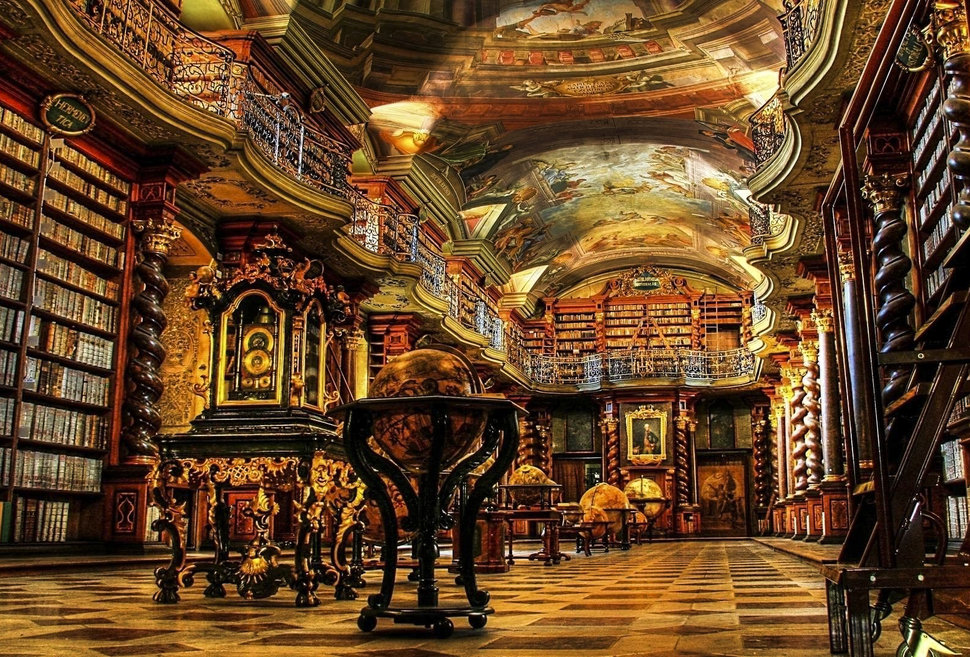
The Clementinum (Klementinum in Czech) is a historic complex of buildings in Prague. Until recently the complex hosted the National, University and Technical libraries, the City Library also being located nearby on Mariánské Náměstí. The Technical library and the Municipal library have moved to the Prague National Technical Library at Technická 6 since 2009. It is currently in use as the National Library of the Czech Republic. In 2005, the Czech National Library received the UNESCO Jikji prize (Memory of the World).
The National Library was founded in 1781 and from 1782 the Clementinum was a legal deposit library. Since 1990, it has been the National Library. It contains a collection of Mozartiana, material pertaining to Tycho Brahe and Comenius, as well as historic examples of Czech literature. The architecture is a notable example of Baroque architecture and Clementinum, covering 20,000 square metres, is the second largest complex of buildings in Prague after the Prague Castle.
Large complex of Klementinum is situated next to the Charles Bridge, right in the historical centre of Prague. Klementinum, built on area of 2 hectares, is one of the largest building complexes in Europe.
No. 18 | State Library Of South Australia
Adelaide, Australia

The State Library of South Australia, located on North Terrace, Adelaide, is the official library of the Australian state of South Australia. It is the largest public research library in the state with a collection focus on South Australian information, and general reference material for information and research purposes.
The building now known as the Mortlock Wing was opened on 18 December 1884 as a Public Library, Museum and Art Gallery for the colony of South Australia with 23,000 books and a staff of three.
The State Library’s rare books collection is the major collection of its kind in South Australia. It comprises Australian and international items which have been identified as having a special interest through subject matter or rarity.
No. 19 | Vennesla Library and Cultural Center
Vennesla, Norway
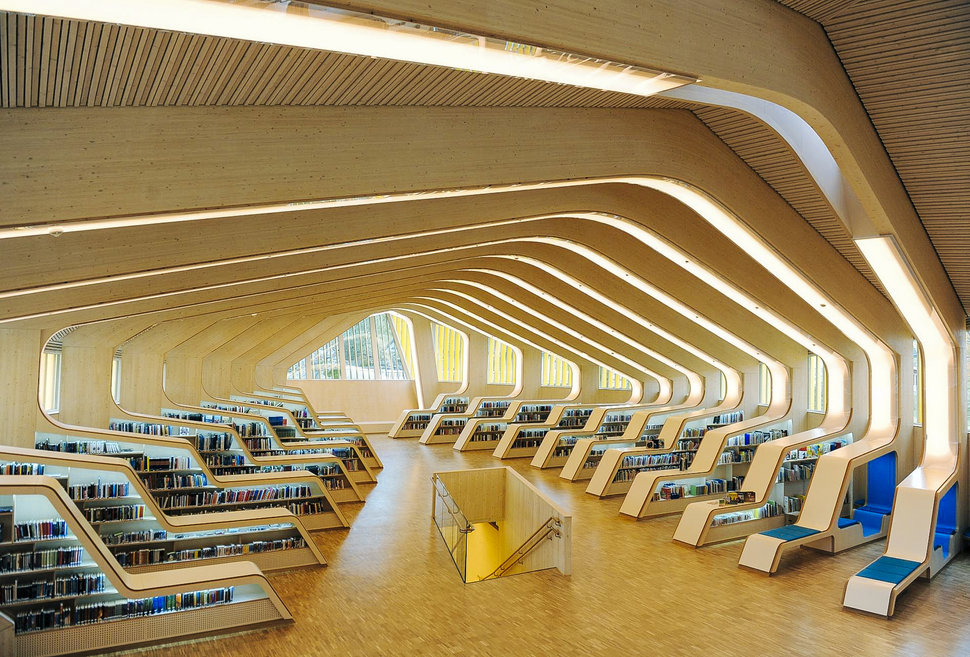
Helen & Hard was founded in 1996 in Stavanger on the west coast of Norway by Norwegian architect Siv Helene Stangeland and Austrian architect Reinhard Kropf. Today, the company has a youthful staff of 26 drawn from 10 different countries, with offices both in Stavanger and Oslo.
The Vennesla Library and Culture House (Norwegian: Vennesla bibliotek og kulturhus) is a public library serving the inhabitants of Vennesla Municipality in Vest-Agder, Norway. The new library building completed in 2011 has won several architecture prizes and has been praised both within Norway and abroad.
The main building material is wood, and the building is dominated by the 27 glue-laminated timber arcs that support the roof and give associations to ribs of a whale skeleton. The building has attracted much interest and won several prizes, among them Statens byggeskikkpris for 2012 (The Norwegian State Prize For Good Buildings)
No. 20 | Seattle Central Library
Seattle, USA

The Seattle Public Library’s Central Library is the flagship library of The Seattle Public Library system. The 11-story (185 feet or 56 meters high) glass and steel building in downtown Seattle, Washington was opened to the public on Sunday.
The 362,987 square feet (33,722.6 m2) public library can hold about 1.45 million books and other materials, features underground public parking for 143 vehicles, and includes over 400 computers open to the public. Over 2 million individuals visited the new library in its first year. It is the third Seattle Central Library building to be located on the same site at 1000 Fourth Avenue, the block bounded by Fourth and Fifth Avenues and Madison and Spring Streets. The library has a unique, striking appearance, consisting of several discrete “floating platforms” seemingly wrapped in a large steel net around glass skin.
On the other hand, usage of the building is more than double the predicted volume. In the library’s first year, 2.3 million people came to visit the library, roughly 30% were out-of-town. The library was also found to have generated $16 million in new economic activity for its surrounding area during this period.
No. 21 | St. Florian Monastery Library
Sankt, Austria
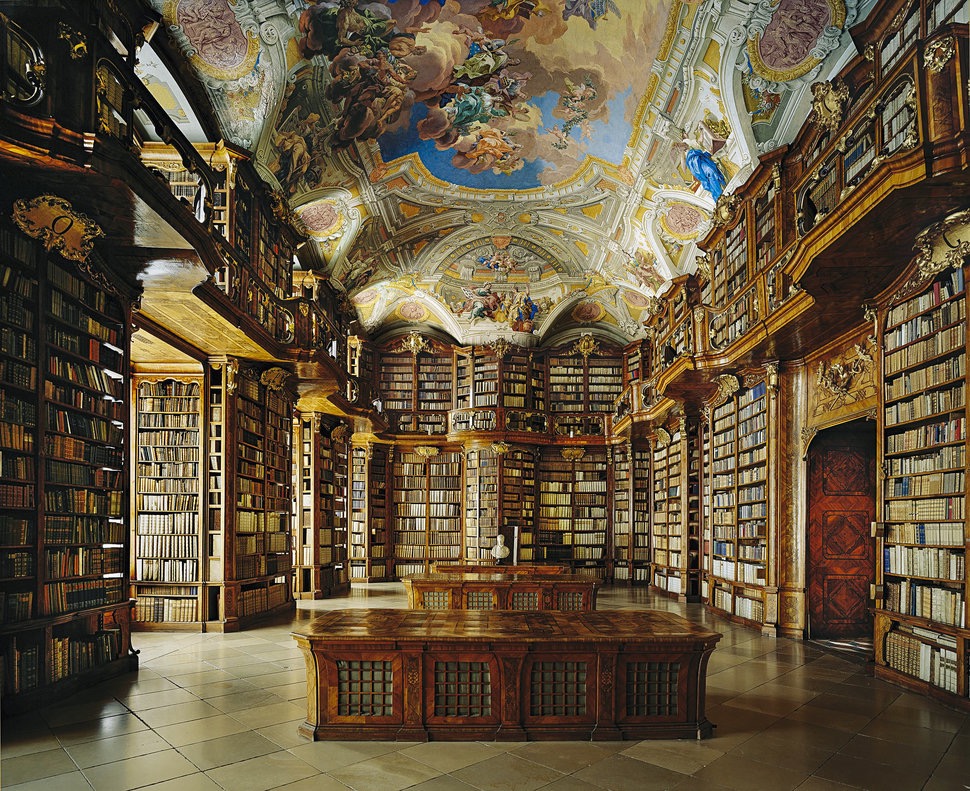
St. Florian Monastery (German: Stift Sankt Florian) is an Augustinian monastery in the town of Sankt Florian, Austria. Founded in the early ninth century, and later refounded by Augustinians in the eleventh century, St. Florian is the largest monastery in Upper Austria, and rivals Melk Abbey and Klosterneuburg Monastery as among the most impressive examples of Baroque architecture in Austria. The monastery is dedicated to Saint Florian, whose fourth century grave lies beneath the monastery.
The Monastery library belongs to the most ancient and most impressive ones in Austria. The gorgeous main hall in late-Baroque impresses by the mighty bookshelves that practically isolate the sphere of the spirit. The colourful ceiling fresco (1747) by Bartolomeo Altomonte (figures) and by Antonio Tassi (architectural painting) shows the marriage of virtue and science under protection of the religion.
The Monastery library possesses a total number of 150,000 volumes out of which 108,000 volumes (60,000 titles) date back before 1900. 952 titles (i.e. 1.6 per cent) are incunables. 35,443 volumes (59.2 per cent) originate from the 16th to the 18th century, while 23,493 volumes (39.2 per cent) come from the 19th century. 800 medieval handscripts present the most precious treasure.
Four showcases in the main hall contain approx. 50 volumes and 600 sheets of cartography from the 16th to the 20th century. They mostly deal with geography, but also genealogy, heraldic and war history. The exlibris collection comprises 253 sheets. The oldest exlibris pieces originate from the first half of the 16th century.
No. 22 | New York Public Library
New York City, USA
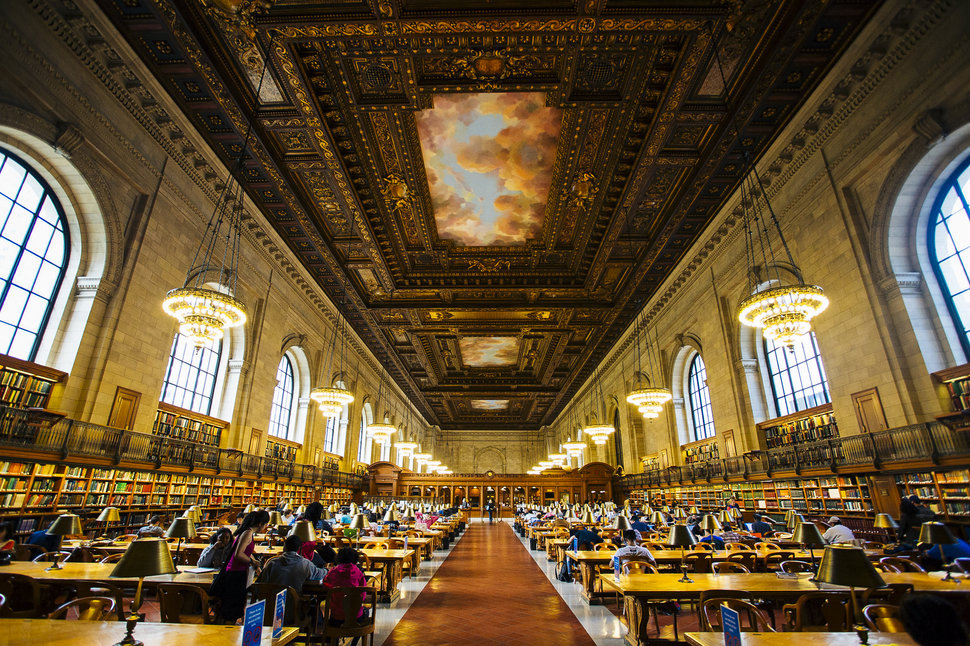
The New York Public Library (NYPL) is a public library system in New York City. With nearly 53 million items, the New York Public Library is the second largest public library in the United States and fourth largest in the world.
The library was developed in the 19th century, founded from an amalgamation of grass-roots libraries, and social libraries of bibliophiles and the wealthy, aided by the philanthropy of the wealthiest Americans of their age.
Today there are four research libraries that comprise the NYPL’s research library system; together they hold approximately 44,000,000 items. Total item holdings, including the collections of the Branch Libraries, are 50.6 million. The Humanities and Social Sciences Library on 42nd Street is still the heart of the NYPL’s research library system. The SIBL, with approximately 2 million volumes and 60,000 periodicals, is the nation’s largest public library devoted solely to science and business.
No. 23 | The George Peabody Library
Baltimore, USA
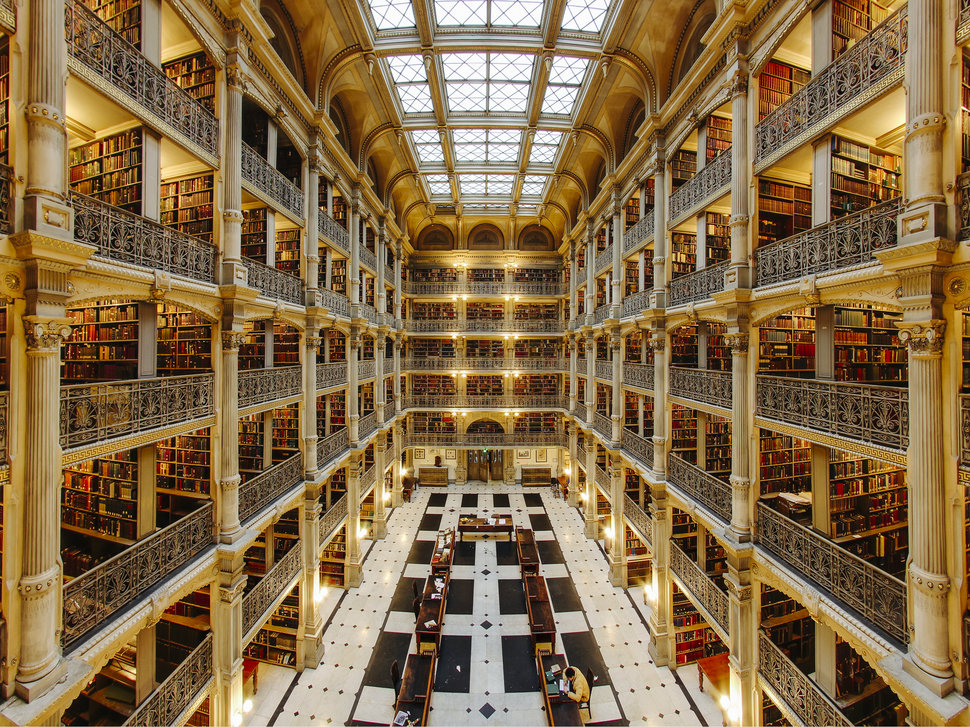
The George Peabody Library, formerly known as the Library of the Peabody Institute, is the 19th-century research library of The Johns Hopkins University. It is located on the Peabody campus at Mount Vernon Place in Baltimore, Maryland. The collections are available for use by the general public, in keeping with the philanthropist George Peabody’s goal to create a library “for the free use of all persons who desire to consult it.
The main collection reflects broad interests of the 19th century, in keeping with Peabody’s desire for it to be “well furnished in every department of knowledge and of the most approved literature.” The library’s 300,000 volume collection is particularly strong in religion, British art, architecture, topography and history; American history, biography, and literature; Romance languages and literature; history of science; and geography, exploration and travel. While the majority of titles date to the 19th century, the library also has a strong assortment of early printed books, cuneiform tablets, and a marquee collection of Don Quixote editions.
No. 24 | Central Library of Vancouver
Vancouver, Canada
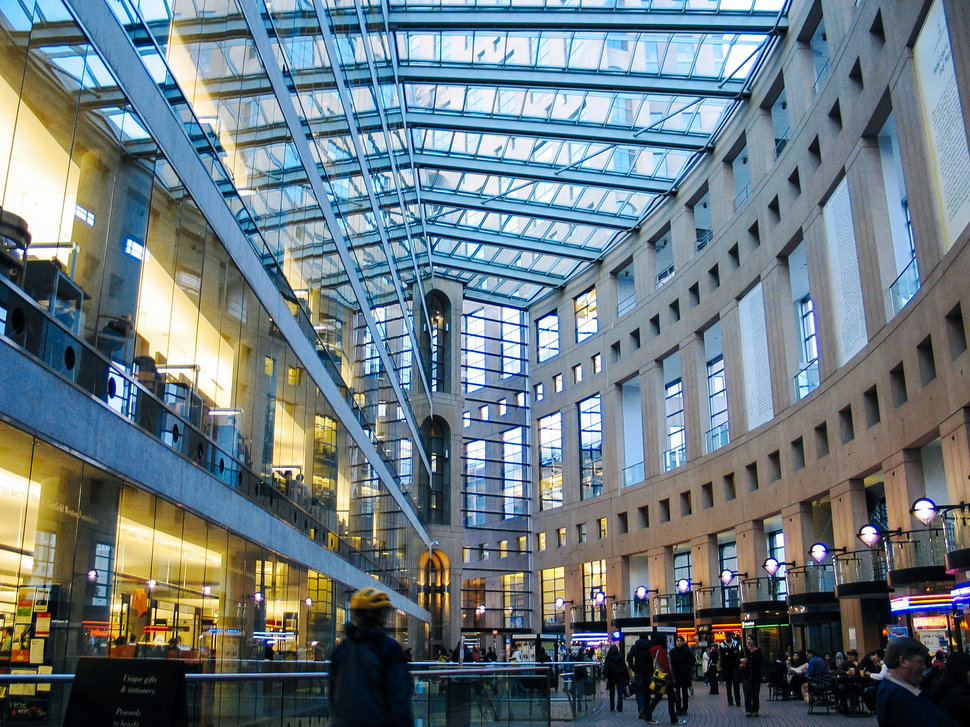
Vancouver Public Library (VPL) is the public library system for the city of Vancouver, British Columbia. In 2013, VPL had more than 6.9 million visits with patrons borrowing nearly 9.5 million items including: books, ebooks, CDs, DVDs, newspapers and magazines. Across 22 locations and online, VPL serves nearly 428,000 active members and is the third-largest public library system in Canada.
Consolidating Vancouver Public Library’s Central Branch, Federal Office Tower, and retail and service facilities, the Library Square occupies a city block in Downtown Vancouver. Centred on the block, the library is a nine-story rectangular box containing book stacks and services, surrounded by a free-standing, elliptical, colonnaded wall featuring reading and study areas that are accessed by bridges spanning skylit light wells.
No. 25 | Sainte-Geneviève Library
Paris, France
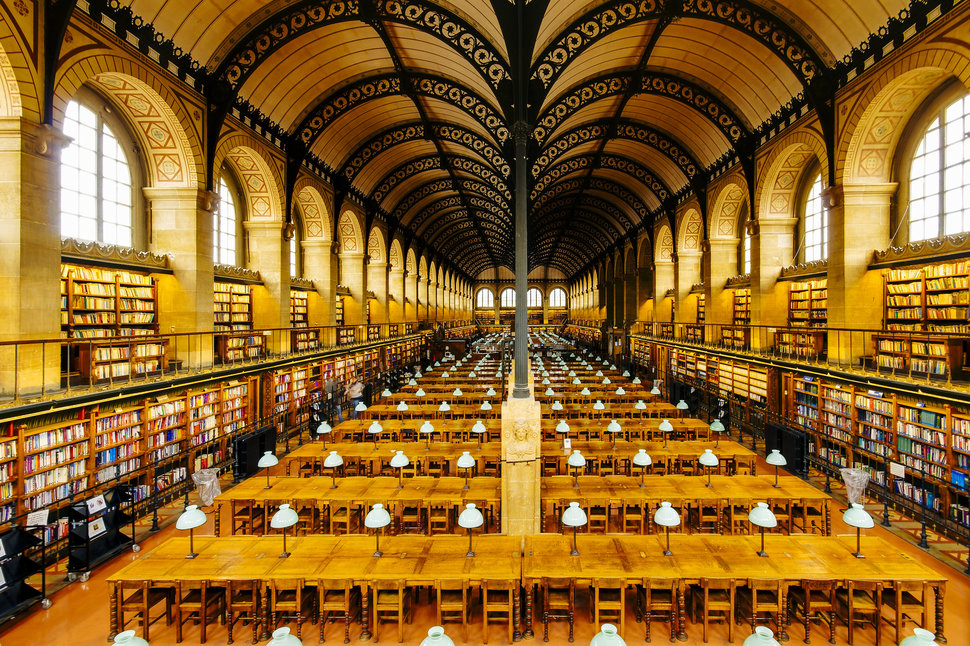
Sainte-Geneviève Library (French: Bibliothèque Sainte-Geneviève) is a public and university library in Paris, which inherited the collection of the Abbey of St Genevieve. The library contains around 2 million documents. It is one of the largest and oldest abbeys in Paris, was founded in the sixth century by Clovis I and subject to the rule of St Benedict.
The Sainte-Geneviève Library was designed and constructed under the direction of the architect Henri Labrouste. The glass and iron reading room has been described as “magisterial” and the building itself as a seminal work in the creation of the modern library as “a temple of knowledge and space for contemplation”. The names of 810 illustrious scholars are inscribed on the building’s facade.



















